A Spray-On Microemulsion with Mold-Proof Effect on Paper
Abstract
1. Introduction
2. Material Identification and Experimental Methods
2.1. Materials
2.2. Isolation and Identification of Mold
2.3. Microemulsion Formulations
2.3.1. The Effect of Mixed CTZ and HACC
2.3.2. Synergistic Role
2.4. Characterization of CH Microemulsion
2.4.1. The Type of CH Microemulsion
2.4.2. Particle Size and Polydispersity Index (PDI) Analysis
2.4.3. Determination of Zeta Potential
2.4.4. TEM Analysis
2.5. Anti-Fungal Experiment
2.6. Mechanical Property Test of Paper after Treatment
2.7. Determination of Optical Properties
2.8. Determination of pH
3. Result and Discussion
3.1. Isolation and Identification of Fungal Contaminants
3.2. The Type of CH Microemulsion
3.3. Globule Size and the Stability Analysis
3.4. Transmission Electron Microscopy
3.5. Effect of Microemulsion Formulations on Mold
3.6. Mechanical Property Test for Paper Samples after Treatment
3.7. Optical Properties
3.8. Measurement of pH Value
4. Conclusions
Supplementary Materials
Author Contributions
Funding
Institutional Review Board Statement
Informed Consent Statement
Data Availability Statement
Acknowledgments
Conflicts of Interest
References
- Mai, B.; Liu, N.; Liu, X.; Teri, G.; Liu, P.; Wang, J.; Li, Y.; Cao, J. Mould prevention of archive packaging based microenvironment intervention and regulation. J. Cult. Herit. 2022, 57, 16–25. [Google Scholar] [CrossRef]
- Xu, J.; Zhang, T.; Jiang, Y.; Chen, Q.; Yang, D.; Qiu, F.; Yu, Z. Synthesis of microcrystalline cellulose/TiO2/fluorine/styrene-acrylate coatings and the application for simulated paper cultural relic protection. Cellulose 2020, 27, 6549–6562. [Google Scholar] [CrossRef]
- Duan, Y.; Chen, R.; Zhang, R.; Jiang, W.; Chen, X.; Yin, C.; Mao, Z. Isolation, Identification, and Antibacterial Mechanisms of Bacillus amyloliquefaciens QSB-6 and Its Effect on Plant Roots. Front. Microbiol. 2021, 12, 746799. [Google Scholar] [CrossRef] [PubMed]
- Chen, Z.; Zou, J.; Chen, B.; Du, L.; Wang, M. Protecting books from mould damage by decreasing paper bioreceptivity to fungal attack using decoloured cell-free supernatant of Lysobacter enzymogenes C3. J. Appl. Microbiol. 2019, 126, 1772–1784. [Google Scholar] [CrossRef]
- Lech, T. Evaluation of a Parchment Document, the 13th Century Incorporation Charter for the City of Krakow, Poland, for Microbial Hazards. Appl. Environ. Microbiol. 2016, 82, 2620–2631. [Google Scholar] [CrossRef]
- Sawoszczuk, T.; Syguła-Cholewińska, J.; del Hoyo-Meléndez, J.M. Application of HS-SPME-GC-MS method for the detection of active moulds on historical parchment. Anal. Bioanal. Chem. 2017, 409, 2297–2307. [Google Scholar] [CrossRef]
- Sterflinger, K. Fungi: Their role in deterioration of cultural heritage. Fungal Biol. Rev. 2010, 24, 47–55. [Google Scholar] [CrossRef]
- Lugauskas, A.; Krikŝtaponis, A. Microscopic Fungi Found in the Libraries of Vilnius and Factors Affecting their Development. Indoor Built Environ. 2004, 13, 169–182. [Google Scholar] [CrossRef]
- Lavin, P.; de Saravia, S.G.; Guiamet, P. Scopulariopsis sp. and Fusarium sp. in the Documentary Heritage: Evaluation of Their Biodeterioration Ability and Antifungal Effect of Two Essential Oils. Microb. Ecol. 2016, 71, 628–633. [Google Scholar] [CrossRef]
- Hashem, F.M.; Shaker, D.S.; Ghorab, M.K.; Nasr, M.; Ismail, A. Formulation, characterization, and clinical evaluation of microemulsion containing clotrimazole for topical delivery. AAPS PharmSciTech 2011, 12, 879–886. [Google Scholar] [CrossRef]
- Ritter, W.; Patzschke, K.; Krause, U.; Stettendorf, S. Pharmacokinetic fundamentals of vaginal treatment with clotrimazole. Chemotherapy 1982, 28 (Suppl. 1), 37–42. [Google Scholar] [CrossRef] [PubMed]
- Pedersen, M.; Bjerregaard, S.; Jacobsen, J.; Sørensen, A.M. A genuine clotrimazole γ-cyclodextrin inclusion complex-isolation, antimycotic activity, toxicity and an unusual dissolution rate. Int. J. Pharm. 1998, 176, 121–131. [Google Scholar] [CrossRef]
- Osman, S.F.; Fett, W.F. Structure of the acidic exopolysaccharide of Pseudomonas marginalis strain ATCC 10844. Carbohydr. Res. 1993, 242, 271–275. [Google Scholar] [CrossRef] [PubMed]
- Jia, Z.; Shen, D.; Xu, W. Synthesis and antibacterial activities of quaternary ammonium salt of chitosan. Carbohydr. Res. 2001, 333, 1–6. [Google Scholar] [CrossRef] [PubMed]
- Zhang, W.; Dai, X.; Zhou, J.; Zhu, G. Antibacterial Bombyx Mori silk fabric modified with reactive chitosan quaternary ammonium salt and its laundering durability. Fibers Polym. 2017, 18, 290–295. [Google Scholar] [CrossRef]
- Zhang, J.; Tan, W.; Li, Q.; Liu, X.; Guo, Z. Preparation of Cross-linked Chitosan Quaternary Ammonium Salt Hydrogel Films Loading Drug of Gentamicin Sulfate for Antibacterial Wound Dressing. Mar. Drugs 2021, 19, 479. [Google Scholar] [CrossRef]
- Chen, M.; Hu, Y.; Zhou, J.; Xie, Y.; Wu, H.; Yuan, T.; Yang, Z. Facile fabrication of tea tree oil-loaded antibacterial microcapsules by complex coacervation of sodium alginate/quaternary ammonium salt of chitosan. RSC Adv. 2016, 6, 13032–13039. [Google Scholar] [CrossRef]
- Zhang, W.; Zhou, J.J.; Dai, X.L. Preparation and characterization of reactive chitosan quaternary ammonium salt and its application in antibacterial finishing of cotton fabric. Text. Res. J. 2016, 87, 759–765. [Google Scholar] [CrossRef]
- Borhade, V.; Pathak, S.; Sharma, S.; Patravale, V. Clotrimazole nanoemulsion for malaria chemotherapy. Part I: Preformulation studies, formulation design and physicochemical evaluation. Int. J. Pharm. 2012, 431, 138–148. [Google Scholar] [CrossRef]
- Kumari, B.; Kesavan, K. Effect of chitosan coating on microemulsion for effective dermal clotrimazole delivery. Pharm. Dev. Technol. 2017, 22, 617–626. [Google Scholar] [CrossRef]
- Zhang, J.; Michniak-Kohn, B.B. Investigation of microemulsion and microemulsion gel formulations for dermal delivery of clotrimazole. Int. J. Pharm. 2018, 536, 345–352. [Google Scholar] [CrossRef] [PubMed]
- Grimling, B.; Karolewicz, B.; Nawrot, U.; Wlodarczyk, K.; Gorniak, A. Physicochemical and Antifungal Properties of Clotrimazole in Combination with High-Molecular Weight Chitosan as a Multifunctional Excipient. Mar. Drugs 2020, 18, 591. [Google Scholar] [CrossRef]
- Alam, M.A.; Al-Janoobi, F.I.; Alzahrani, K.A.; Al-Agamy, M.H.; Abdelgalil, A.A.; Al-Mohizea, A.M. In-vitro efficacies of topical microemulsions of clotrimazole and ketoconazole; and in-vivo performance of clotrimazole microemulsion. J. Drug Deliv. Sci. Technol. 2017, 39, 408–416. [Google Scholar] [CrossRef]
- Wassano, N.S.; Goldman, G.H.; Damasio, A. Aspergillus fumigatus. Trends Microbiol. 2020, 28, 594–595. [Google Scholar] [CrossRef]
- Xu, Q.; Jiang, X.; Tong, J.; Wu, H.; Luo, Y.; Shi, J. Penicillium oxalicum SL2 as a sustainable option to mitigate the accumulation of Pb in rice (Oryza sativa L.). Sci. Total Environ. 2022, 823, 153769. [Google Scholar] [CrossRef] [PubMed]
- Amaike, S.; Keller, N.P. Aspergillus flavus. Annu. Rev. Phytopathol. 2011, 49, 107–133. [Google Scholar] [CrossRef]
- Schuster, E.; Dunn-Coleman, N.; Frisvad, J.; van Dijck, P. On the safety of Aspergillus niger—A review. Appl. Microbiol. Biotechnol. 2002, 59, 426–435. [Google Scholar] [CrossRef] [PubMed]
- Khan, S.A.; Hamayun, M.; Yoon, H.; Kim, H.Y.; Suh, S.J.; Hwang, S.K.; Kim, J.M.; Lee, I.J.; Choo, Y.S.; Yoon, U.H.; et al. Plant growth promotion and Penicillium citrinum. BMC Microbiol. 2008, 8, 231. [Google Scholar] [CrossRef] [PubMed]
- Peterson, S.W.; Jurjević, Ž. New species of Talaromyces isolated from maize, indoor air, and other substrates. Mycologia 2017, 109, 537–556. [Google Scholar] [CrossRef]
- Asis, A.; Shahriar, S.A.; Naher, L.; Saallah, S.; Fatihah, H.N.N.; Kumar, V.; Siddiquee, S. Identification patterns of Trichoderma strains using morphological characteristics, phylogenetic analyses and lignocellulolytic activities. Mol. Biol. Rep. 2021, 48, 3285–3301. [Google Scholar] [CrossRef]
- Gaba, B.; Khan, T.; Haider, M.F.; Alam, T.; Baboota, S.; Parvez, S.; Ali, J. Vitamin E Loaded Naringenin Nanoemulsion via Intranasal Delivery for the Management of Oxidative Stress in a 6-OHDA Parkinson’s Disease Model. Biomed. Res. Int. 2019, 2019, 2382563. [Google Scholar] [CrossRef] [PubMed]
- Srivastava, M.; Kohli, K.; Ali, M. Formulation development of novel in situ nanoemulgel (NEG) of ketoprofen for the treatment of periodontitis. Drug Deliv. 2016, 23, 154–166. [Google Scholar] [CrossRef] [PubMed]
- Carlsson, L.A.; Lindstrom, T. A shear-lag approach to the tensile strength of paper. Compos. Sci. Technol. 2005, 65, 183–189. [Google Scholar] [CrossRef]
- Kamel, S.; El-Sakhawy, M.; Nada, A.M.A. Mechanical properties of the paper sheets treated with different polymers. Thermochim. Acta 2004, 421, 81–85. [Google Scholar] [CrossRef]
- Wu, X.; Mou, H.; Fan, H.; Yin, J.; Liu, Y.; Liu, J. Improving the flexibility and durability of aged paper with bacterial cellulose. Mater. Today Commun. 2022, 32, 103827. [Google Scholar] [CrossRef]
- Fu, P.; Teri, G.-L.; Chao, X.-L.; Li, J.; Li, Y.-H.; Yang, H. Modified Graphene-FEVE Composite Coatings: Application in the Repair of Ancient Architectural Color Paintings. Coatings 2020, 10, 1162. [Google Scholar] [CrossRef]
- Milanovic, J.; Lazic, T.; Zivkovic, I.; Vuksanovic, M.; Milosevic, M.; Kostic, M. The Effect of Nanofibrillated Tempo-oxidized Cotton Linters on the Strength and Optical Properties of Paper. J. Nat. Fibers 2020, 19, 3993–4006. [Google Scholar] [CrossRef]
- Vajová, I.; Vizárová, K.; Tiňo, R.; Krivoňáková, N.A.; Takáč, Z.; Katuščák, S. Determination of pH distribution through pH-related properties in deacidified model paper. Eur. Phys. J. Plus 2021, 136, 578. [Google Scholar] [CrossRef]
- McClements, D.J. Nanoemulsions versus microemulsions: Terminology, differences, and similarities. Soft Matter 2012, 8, 1719–1729. [Google Scholar] [CrossRef]
- Garti, N.; Spernath, A.; Aserin, A.; Lutz, R. Nano-sized self-assemblies of nonionic surfactants as solubilization reservoirs and microreactors for food systems. Soft Matter 2005, 1, 206–218. [Google Scholar] [CrossRef]
- Adel, A.M.; Ahmed, N.M.; Diab, M.A.; Selim, M.M. The influence of TiO2/CC core/shell pigments on the properties of paper sheets. Powder Technol. 2016, 291, 437–447. [Google Scholar] [CrossRef]
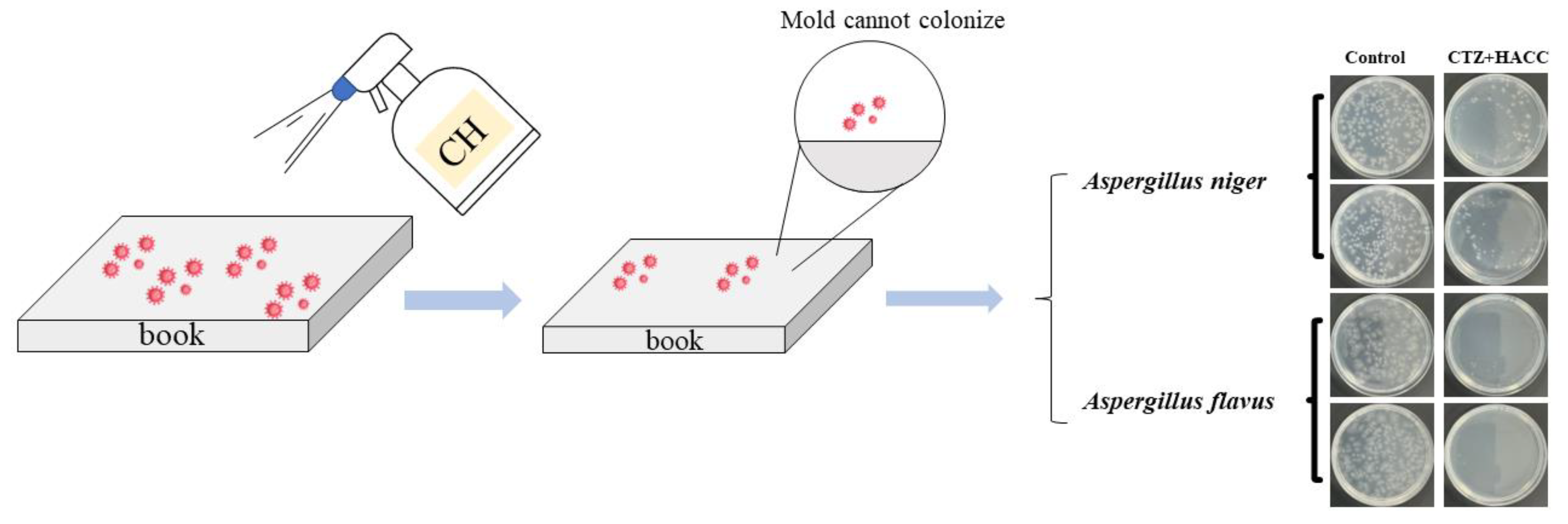
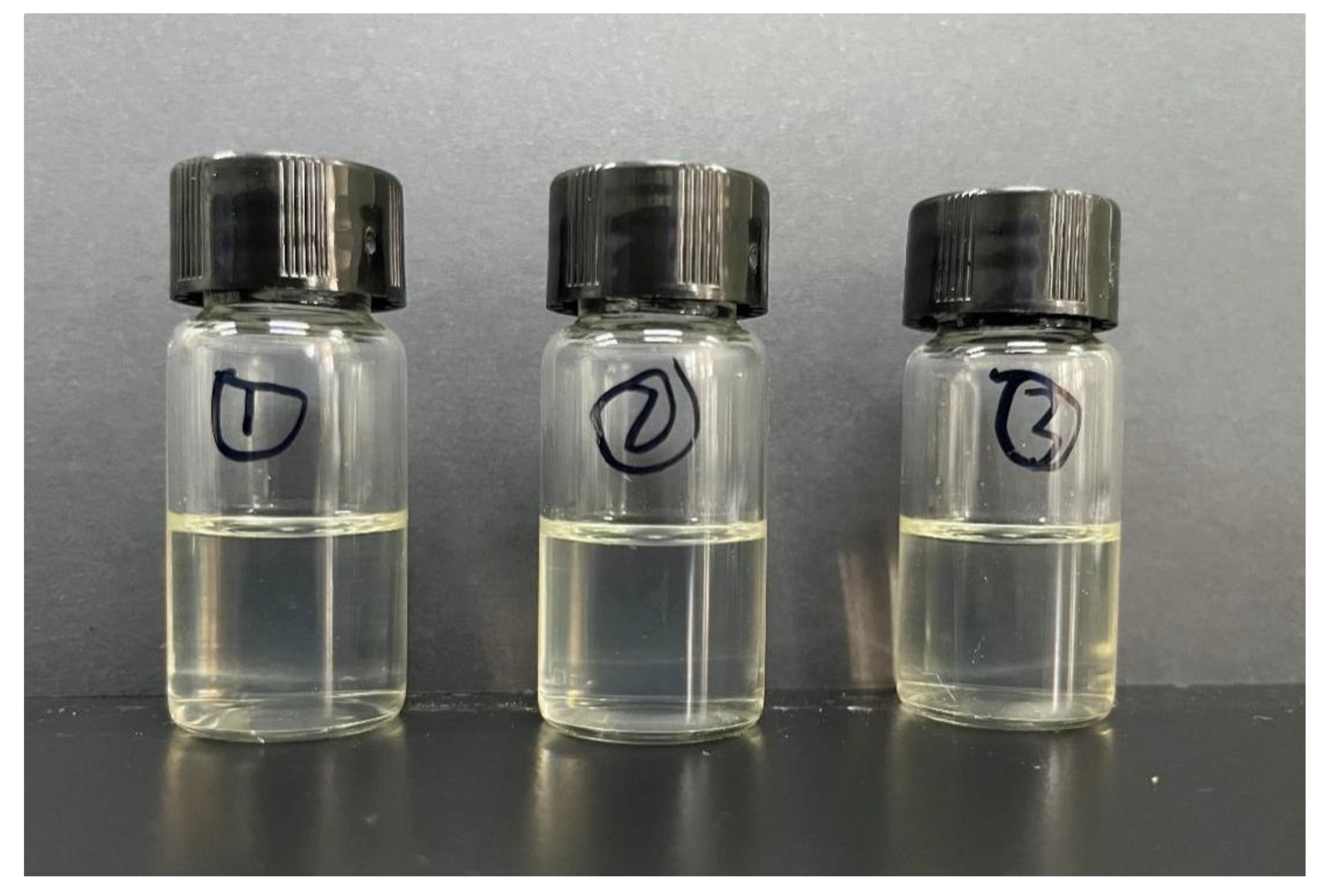
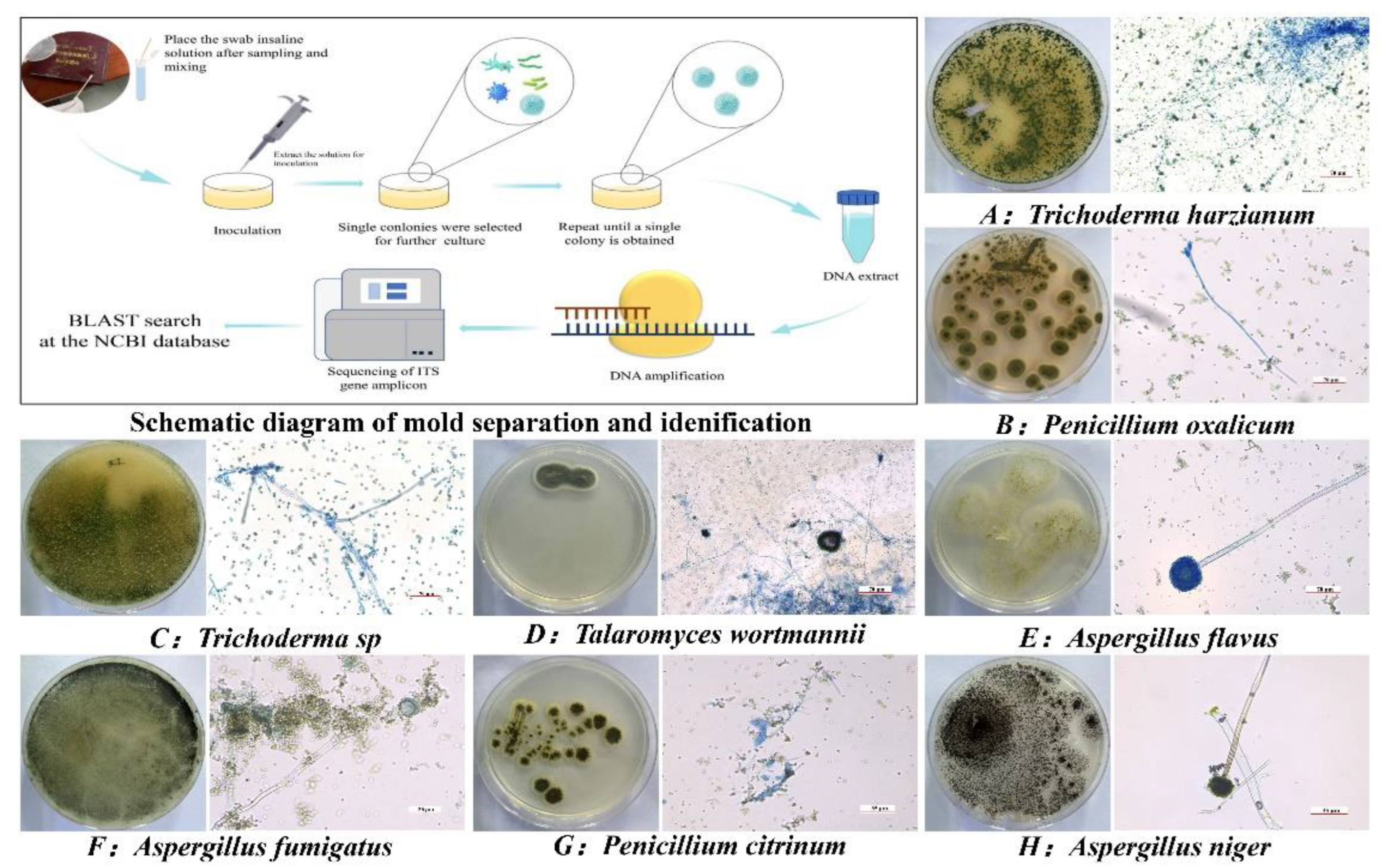
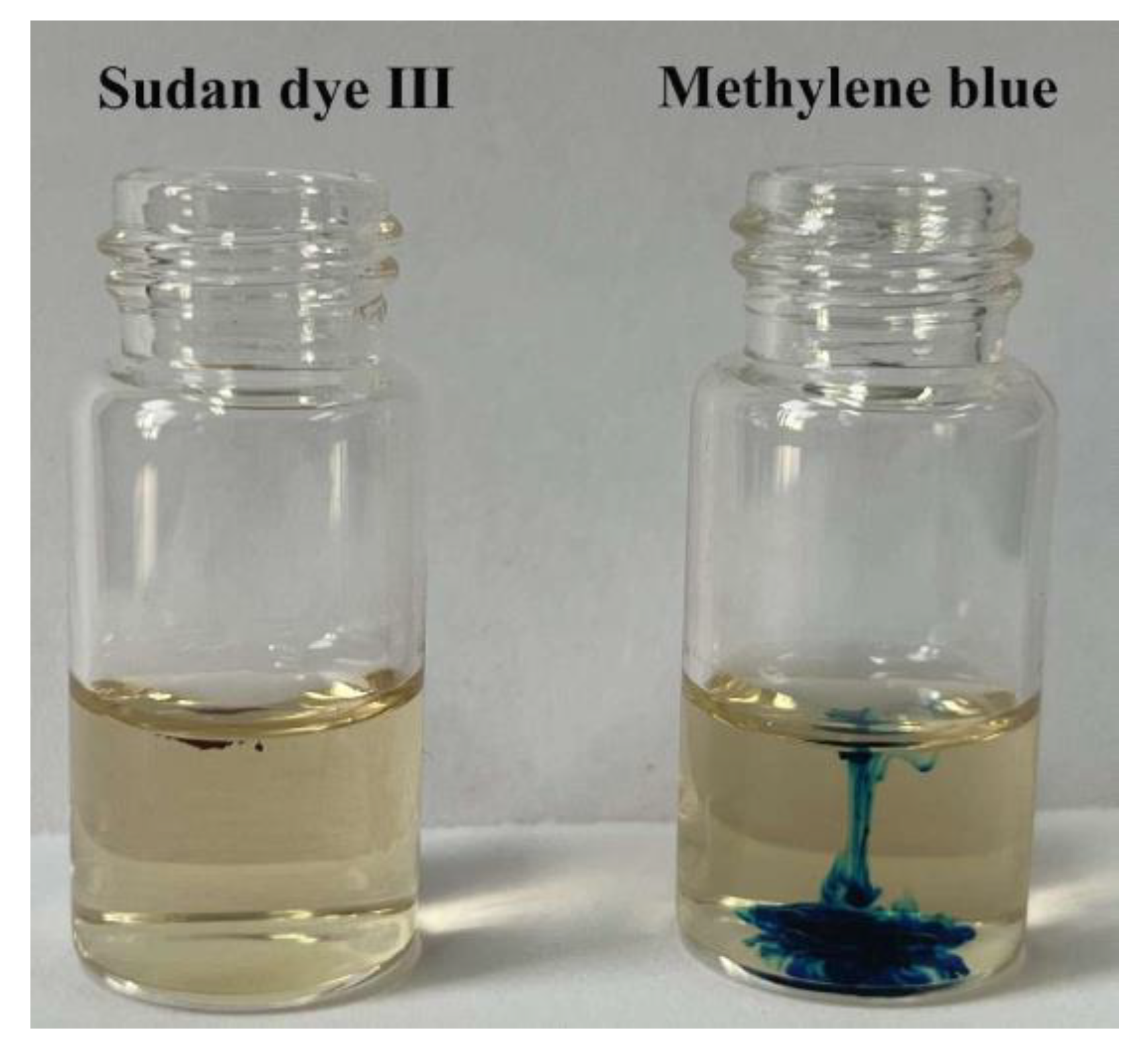
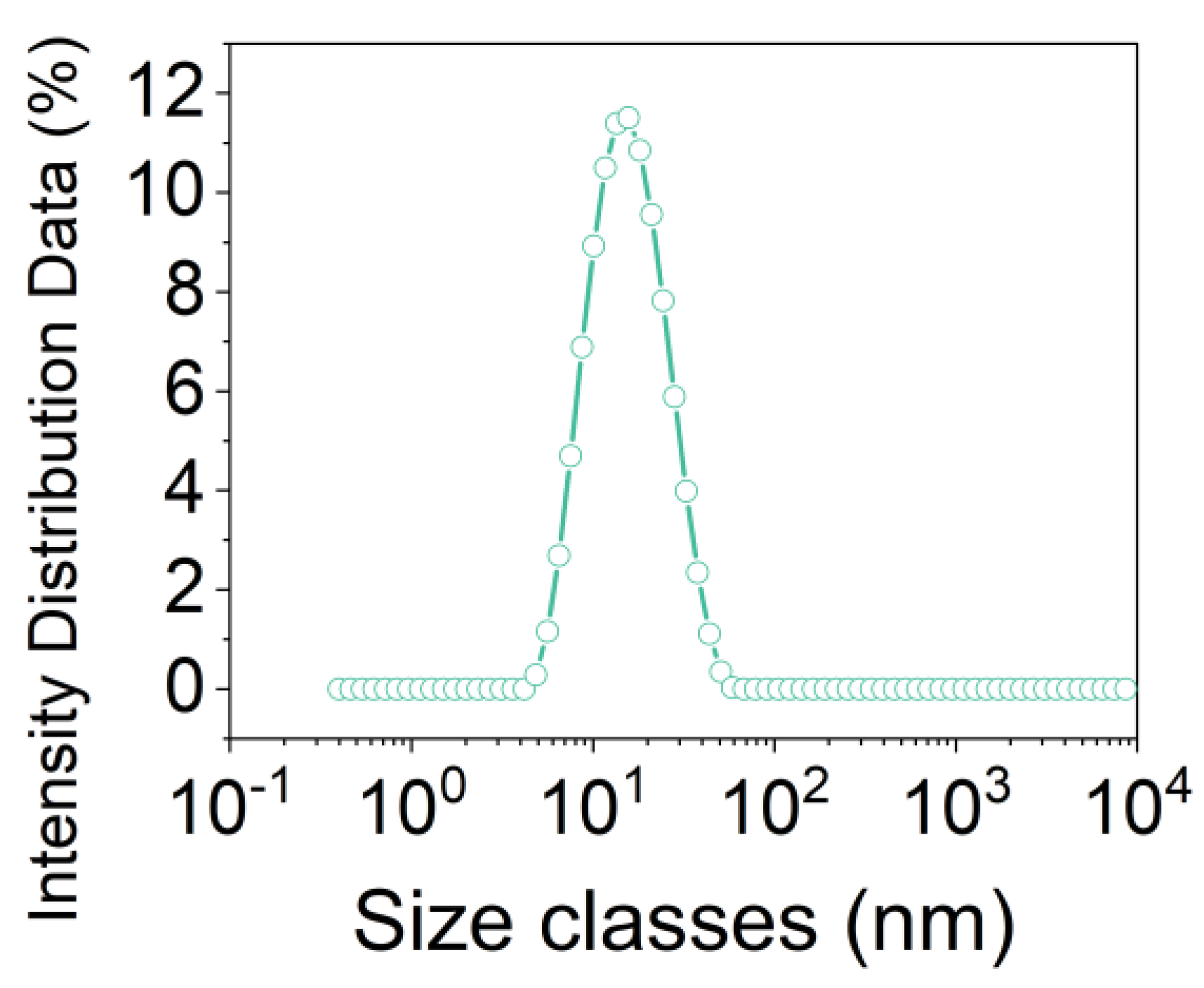
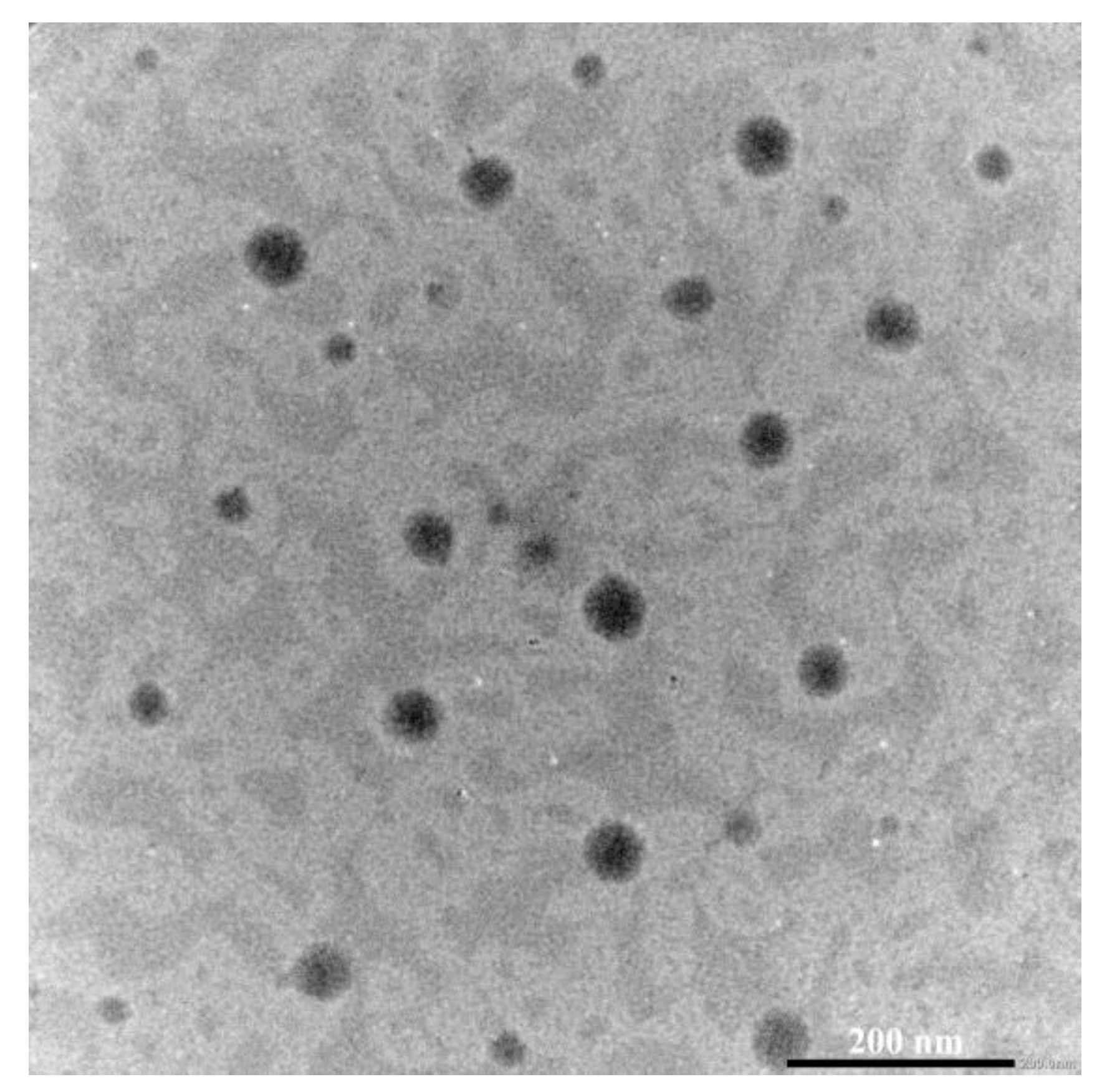
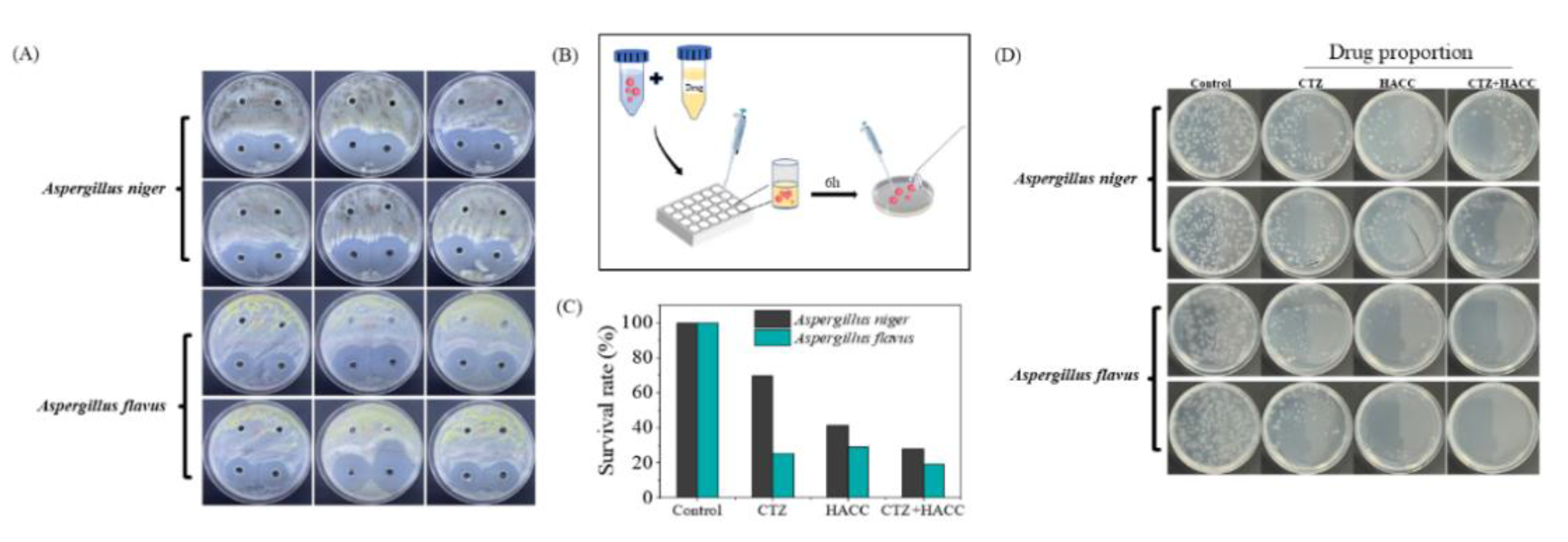
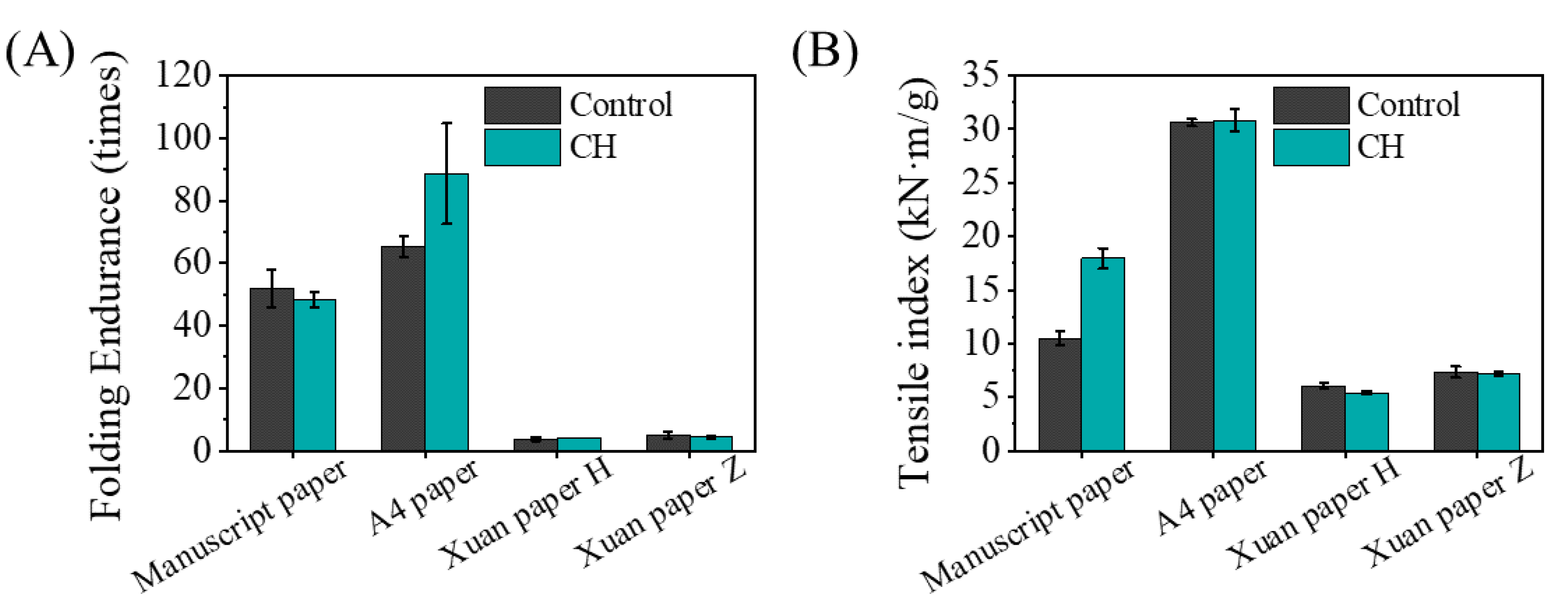
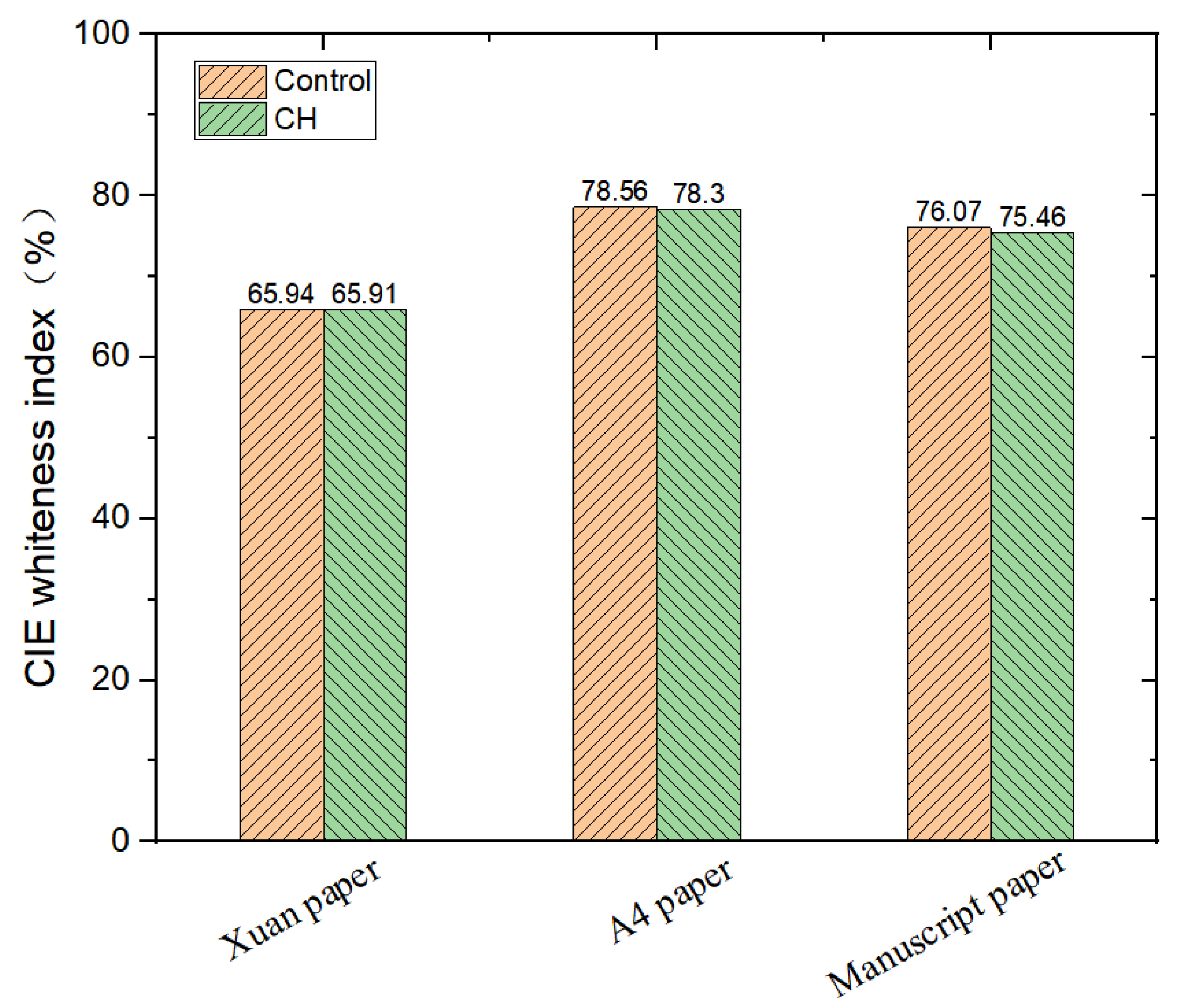
| Code | CTZ | HACC | Clove Oil | Tween-20 | Aqueous Phase (mL) | Sonication |
|---|---|---|---|---|---|---|
| a | 50 mg | 0 mg | 300 μL | 1.5 mL | 3.5 mL | Bath |
| b | 0 mg | 50 mg | 300 μL | 1.5 mL | 3.5 mL | Bath |
| c | 25 mg | 25 mg | 300 μL | 1.5 mL | 3.5 mL | Bath |
| Code | CTZ | HACC | Clove Oil | Tween-20 | Aqueous Phase (mL) | Sonication |
|---|---|---|---|---|---|---|
| C | 2 mg | 0 mg | 300 μL | 1.5 mL | 3.5 mL | Bath |
| H | 0 mg | 0.0625 mg | 300 μL | 1.5 mL | 3.5 mL | Bath |
| CH | 2 mg | 0.0625 mg | 300 μL | 1.5 mL | 3.5 mL | Bath |
| Sample | Color Values | Total Color Differences ΔE | |||
|---|---|---|---|---|---|
| L* | a* | b* | |||
| Control | Xuan paper | 89.04 | −0.82 | 2.21 | / |
| manuscript paper | 90.93 | −0.12 | −3.55 | / | |
| A4 paper | 89.83 | 2.31 | −9.43 | / | |
| CH | Xuan paper | 89.71 | −0.76 | 1.95 | 0.49 |
| manuscript paper | 89.13 | −0.15 | −3.6 | 1.13 | |
| A4 paper | 89.82 | 2.1 | −9.33 | 0.28 | |
| Xuan Paper | Manuscript Paper | A4 Paper | |
|---|---|---|---|
| Control | 6.68 | 7.96 | 8.26 |
| CH | 6.70 | 7.78 | 8.36 |
Disclaimer/Publisher’s Note: The statements, opinions and data contained in all publications are solely those of the individual author(s) and contributor(s) and not of MDPI and/or the editor(s). MDPI and/or the editor(s) disclaim responsibility for any injury to people or property resulting from any ideas, methods, instructions or products referred to in the content. |
© 2023 by the authors. Licensee MDPI, Basel, Switzerland. This article is an open access article distributed under the terms and conditions of the Creative Commons Attribution (CC BY) license (https://creativecommons.org/licenses/by/4.0/).
Share and Cite
Liu, N.; Chu, D.; Chen, X.; Fu, P.; Xing, H.; Chao, X.; Luo, Y.; Mai, B.; Li, Y. A Spray-On Microemulsion with Mold-Proof Effect on Paper. Coatings 2023, 13, 745. https://doi.org/10.3390/coatings13040745
Liu N, Chu D, Chen X, Fu P, Xing H, Chao X, Luo Y, Mai B, Li Y. A Spray-On Microemulsion with Mold-Proof Effect on Paper. Coatings. 2023; 13(4):745. https://doi.org/10.3390/coatings13040745
Chicago/Turabian StyleLiu, Naiming, Depeng Chu, Xianlin Chen, Peng Fu, Huiping Xing, Xiaolian Chao, Yujia Luo, Bingjie Mai, and Yuhu Li. 2023. "A Spray-On Microemulsion with Mold-Proof Effect on Paper" Coatings 13, no. 4: 745. https://doi.org/10.3390/coatings13040745
APA StyleLiu, N., Chu, D., Chen, X., Fu, P., Xing, H., Chao, X., Luo, Y., Mai, B., & Li, Y. (2023). A Spray-On Microemulsion with Mold-Proof Effect on Paper. Coatings, 13(4), 745. https://doi.org/10.3390/coatings13040745







